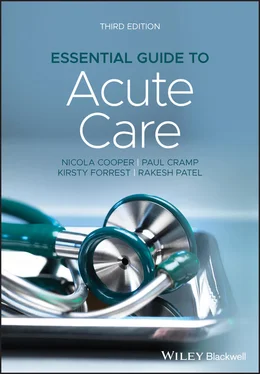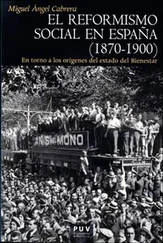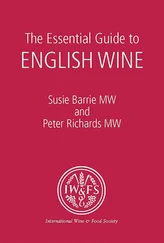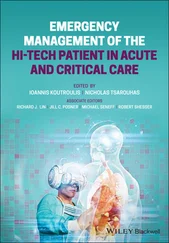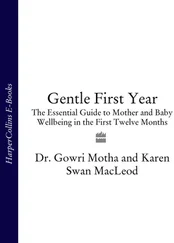1 Cover
2 Title Page Essential Guide to Acute Care Third Edition Nicola Cooper MBChB FRCPE FRACP FAcadMEd SFHEA Consultant Physician & Clinical Associate Professor in Medical Education University Hospitals of Derby & Burton NHS Foundation Trust, UK Paul Cramp BSc MBChB FRCA FRCP FFICM Consultant in Anaesthesia and Intensive Care (retired) Bradford Teaching Hospitals NHS Foundation Trust Kirsty Forrest MBChB BSc(hons) MMed FRCA FAcadMEd FANZCA Dean of Medicine and Consultant in Anaesthesia Bond University, Faculty of Health Sciences & Medicine, Gold Coast, Australia Rakesh Patel MRCP MD MMed SFHEA Clinical Associate Professor in Medical Education & Honorary Consultant Nephrologist Medical Education Centre, University of Nottingham, UK
3 Copyright Page
4 Reviews of the Second Edition
5 Introduction
6 Acknowledgements
7 Foreword to the Second Edition
8 Units Used in This Book
9 List of Abbreviations
10 CHAPTER 1: Patients at Risk What is Resuscitation? Medical Emergency Teams Do Early Warning Scores and Medical Emergency Teams Make a Difference? ABCDE – An Overview Special Considerations in the Geriatric Population The Benefits and Limitations of Intensive Care Communication and the Critically Ill References Further Resources
11 CHAPTER 2: Oxygen Therapy Myths About Oxygen Hypoxaemia and Hypoxia Oxygen Therapy Can Oxygen Therapy Be Harmful? Hypercapnia and Oxygen Therapy Pulse Oximetry Oxygen Delivery Self‐Assessment: Case Histories Self‐Assessment: Discussion References Further Resources
12 CHAPTER 3: Acid–Base Balance Acid as a By‐Product of Metabolism Some Definitions Common Causes of Acid–Base Disturbances Respiratory Alkalosis Interpreting an Arterial Blood Gas Report Why Arterial Blood Gas Analysis is Important in Critical Illness Self‐Assessment: Case Histories Self‐Assessment: Discussion Appendix – Checking the Consistency of Arterial Blood Gas Data References Further Resources
13 CHAPTER 4: Respiratory Failure Basic Pulmonary Physiology The Mechanisms of Respiratory Failure Respiratory Support Non‐Invasive Respiratory Support Invasive Respiratory Support The Effects of Mechanical Ventilation Self‐Assessment: Case Histories Self‐Assessment: Discussion References Further Resources
14 CHAPTER 5: Fluid Balance and Volume Resuscitation Blood Pressure Fluid Balance in Health Versus Illness Sodium and Water Homeostasis in Illness Prescribing Fluid Assessing Volume Status Different Types of Fluid Crystalloids Blood Self‐Assessment: Case Histories Self‐Assessment: Discussion References Further Resources
15 CHAPTER 6: Sepsis Definition of Sepsis Basic Pathophysiology of Sepsis Screening Tools for Sepsis Sepsis Six Management of Sepsis and Septic Shock Vasopressors and Inotropes The Effects of Sepsis on the Lungs and Kidneys Other Supportive Care on the Intensive Care Unit Self‐Assessment: Case Histories Self‐Assessment: Discussion References
16 CHAPTER 7: Acute Kidney Injury Definitions Basic Renal Physiology The Pathophysiology of AKI Preventing AKI Assessment of Patients with AKI Management of AKI Prognosis of AKI Self‐Assessment: Case Histories Self‐Assessment: Discussion References
17 CHAPTER 8: Brain Injury Cerebral Blood Flow Intracranial Pressure Primary and Secondary Brain Injury Principles of Brain Protection The Unconscious Patient Prognosis Following Cardiac Arrest Self‐Assessment: Case Histories Self‐Assessment: Discussion References
18 CHAPTER 9: Optimising Patients Before Surgery The Development of Perioperative Care Risk Assessment in the Preoperative Patient The Medical Consultation The Assessment and Management of Patients with Cardiac Disease The Assessment of Patients with Respiratory and Other Diseases Preoperative Assessment of Elderly Patients Basic Preoperative Optimisation Self‐Assessment: Discussion References Further Resources
19 CHAPTER 10: Pain Control and Sedation Physiology of Acute Pain An Analgesic Ladder An Antiemetic Ladder Local Anaesthesia Self‐Assessment: Case Histories Self‐Assessment: Discussion References Further Resources
20 Index
21 End User License Agreement
1 Chapter 1 Table 1.1 UK National Early Warning Score (NEWS2). Table 1.2 UK severity of illness classification.
2 Chapter 2 Table 2.1 Theoretical oxygen concentrations for nasal cannulae. Table 2.2 Venturi mask flow rates. Table 2.3 Which mask for which patient? Table 2.4 CO 2retention due to oxygen therapy versus ventilatory failure in p... Table 2.5 Half‐life of CO depending on conditions.
3 Chapter 3Table 3.1 Renal and respiratory compensation.Table 3.2 Changes in pH, PaCO 2, and standard bicarbonate in different acid–ba...Table 3.3 pH and equivalent [H +].
4 Chapter 4Table 4.1 Approach to the patient with respiratory failure.Table 4.2 First‐line methods of respiratory support for different causes of a...Table 4.3 Complications of non‐invasive respiratory support versus intubation...Table 4.4 Advantages and disadvantages of volume versus pressure control.
5 Chapter 5Table 5.1 Factors that affect myocardial contractility.Table 5.2 Characteristic haemodynamic variables in different types of shock.Table 5.3 Flow rates of different sized venous cannulae.Table 5.4 Electrolyte content of common crystalloids in mmol/L (mg/dL).Table 5.5 Electrolyte content of common colloids in mmol/L (mg/dL).
6 Chapter 6Table 6.1 Sepsis‐3 definitions.Table 6.2 SOFA score.Table 6.3 Mortality of sepsis on ICU according to number of failing organs.Table 6.4 SSC 1 hour sepsis bundle.Table 6.5 Sepsis six.Table 6.6 Receptors in the circulation and the action of common vasoactive dr...Table 6.7 Location and functions of vasopressin receptors.
7 Chapter 7Table 7.1 Staging of AKI (KDIGO 2012 definitions).Table 7.2 Definitions of CKD.Table 7.3 ‘Classical’ clinical patterns in renal disease.
8 Chapter 8Table 8.1 Methods to prevent raised intracranial pressure.Table 8.2 Summary of basic management to prevent secondary brain injury.Table 8.3 Glasgow Coma Score (GCS).
9 Chapter 9Table 9.1 NCEPOD themes and recommendations.Table 9.2 ASA classification of disease severity.Table 9.3 Scales of risk.Table 9.4 Patient risk factors that predict perioperative cardiac complicatio...Table 9.5 Risk associated with different procedures.Table 9.6 Recommendations for perioperative β‐blockers.Table 9.7 Diagnostic criteria for heart failure.Table 9.8 Components of CGA.
1 Chapter 2 Figure 2.1 Different oxygen masks. Figure 2.2 A 28% Venturi mask. Bernoulli’s equation for incompressible flow ... Figure 2.3 Lower total flow rates in patients with high inspiratory demands.... Figure 2.4 Simple guide to oxygen therapy for acutely ill patients. Nasal ca... Figure 2.5 The balance between respiratory muscle load and strength. Figure 2.6 Absorption in a pulse oximeter. Components of absorption. Tissue,... Figure 2.7 The oxygen dissociation curve. The oxygen dissociation curve fall...
2 Chapter 4Figure 4.1 Normal lung volumes. The closing volume (CV) is the volume at whi...Figure 4.2 Pressure changes in the alveolus during normal breathing.Figure 4.3 The oxygen cascade.Figure 4.4 V/Q mismatch versus shunt.Figure 4.5 Different types of respiratory support. BiPAP = bilevel positive ...Figure 4.6 The difference between non‐invasive BiPAP and CPAP. With non‐inva...Figure 4.7 A CPAP circuit.Figure 4.8 How CPAP reduces afterload.Figure 4.9 Waveforms of different ventilator modes. A = BiPAP in a paralysed...Figure 4.10 Algorithm for the management of respiratory failure. The appropr...
3 Chapter 5Figure 5.1 Water distribution in the body of a 70 kg man. ICF: intracellular...Figure 5.2 Sodium and water retention in illness.Figure 5.3 Responses to increasing hypovolaemia in bleeding.Figure 5.4 The effect of fluid challenges versus maintenance fluids on intra...Figure 5.5 The response of the CVP to fluid challenges. In a hypovolaemic pa...
Читать дальше
